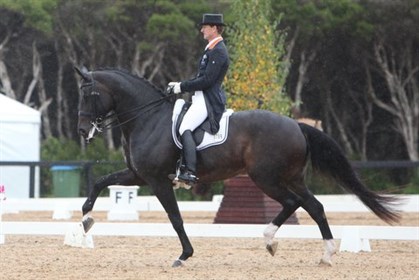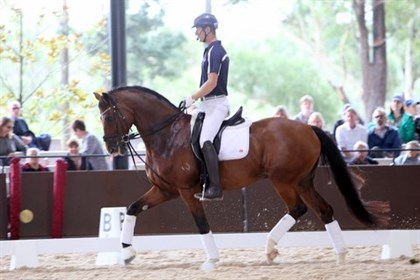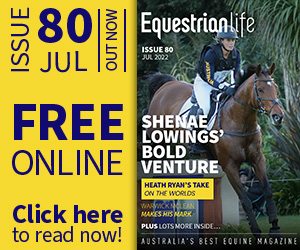
This article has appeared previously with Equestrian Life. To see what is in our latest issue, please click here.
Brett Parbery and Fursten Friendship.
© Roger Fitzhardinge
By Brett Parbery
In the world of equestrian sport, it is widely known that to perform at one’s best on any given day, both the horse and rider must be in a sound and focused state of mind. However, as most equestrian enthusiasts will tell you, the chances of getting this to happen on the same day are remote, often occurring more by a stroke of good luck than by good management.
What I would like to discuss in is how to get yourself in the right frame of mind to allow you to compete at your best, whether it be at your local riding club or at a major international championship. As I see it, the mental state of the rider is a good place to start when it comes to being well prepared for a competition, so let’s leave the horses out of it for a moment and focus on the rider.
The mental side of high-level sport is a subject widely studied throughout the world. People such as Tiger Woods, Roger Federer and Michael Schumacher are said to be successful not because they are the most talented in their sport, but because they have intense levels of concentration and mental toughness. They have an ability to remain focused even in the most high-pressure situations.
They maintain a hunger to win, and to win they must have the desire to do whatever it takes. That’s why you hear of them practising for hours and hours, spending a large proportion of their time on identifying their weaknesses and working on strengthening them. They will work relentlessly through a countless number of scenarios just so that, on the day of competition when it all matters most, they will be ready for anything and carry with them a confidence that they are ready to perform at their best.
To be a top equestrian we need to adopt the same relentless attitude. But, as we work with living creatures, we cannot work our horses for the same number of hours each day that Roger Federer would be working with his tennis racquet. Therefore, as riders, we have to get it right more times than not and I have identified a few ways to make this happen.
I’m sure all riders will agree that on some days they feel so connected to their horse that they can do no wrong. The horse feels obedient, supple and reactive and the sport of dressage suddenly feels easy. Well at least it lasts for a day, because then come the days when nothing feels right and you feel like you have completely lost your touch. Don’t worry, we all have those days and I have discovered that the more concentrated I am in those first few minutes after mounting my horse, the more often I have those blissful days.
Brett Parbery riding Bloomfield Royalist. © Roger Fitzhardinge
In 2008, at a show in Aachen, Germany, I had just finished my Grand Prix when the famous Dutch coach Sjef Janssen came up to me and said, “You are a great rider, man, but you need to learn how to concentrate”. He went on to say, “The difference between Anky and Isabel (who were dominant at the time), is that they can concentrate better than anybody else … people who concentrate don’t make mistakes!” and he left me with that. I have heeded that advice ever since and have worked on my levels of concentration and noted the gaps that exist. I can say that my Grand Prix Special ride at the World Equestrian Games 2010, was the most focused and concentrated I have ever been and yielded my best result.
The ability to concentrate is a skill that cannot be instantly attained; it must be developed, because it’s myself and my horse, clearing my mind of the clutter. I then take up the contact and continue to walk and try to build some focus. Th e focus I am trying to build involves me feeling supple through my hips and back, enough to allow me to feel every fi bre of my horse underneath me. I try to feel every muscle moving, the skeleton of the horse, everything through to their feet touching the ground. Even when I am pushed for time, I try never to shortcut this process because I have found it extremely benefi cial. It is important for me to get a feel for my horse, its natural way of moving.
I then progress into a nice relaxed trot. It might not be the big fancy trot, but a nice relaxed, suppling trot, just getting the wheels turning and getting things started. I feel the warm up can be as long or as short as you like, with the length determined by how productive you have been. You need to use this time eff ectively by staying focused and developing your concentration and overall feel for the different parts of your horse. For example, we know when we are on the correct diagonal in rising trot that the outside front leg will rise and fall at the same time as we rise and sit. Therefore, the gait of the horse tells us that the inside hind leg is doing the same, and correspondingly the outside hind leg is doing the opposite, allowing you to form a mental picture of the action of the hind legs in your mind, all within the fi rst few minutes of your warm up. The canter is the same.
The outside hind leg will hit the ground as the first beat of the canter stride and the inside hind leg as the second beat. The more you develop the image of the hind legs, the more feel you will develop for the whole horse and not just the part you can see in front of you. Creating within yourself this ability to ride with what I call your ‘third eye’, will open up new pathways in your mind for feeling your horse as a whole.
The subject of mental imagery is now not as foreign to sportspeople as it used to be. When I was immersed in the cowboy culture in the 1990s and solely focused on riding saddle broncs week in and week out, learning the art of mental imagery was of growing interest to my fellow competitors. Most of the top contestants were into it and because rodeo is such an explosive sport with very little time to consciously process your thoughts, mental imagery became a way to repetitively rehearse scenarios and the reaction time within those scenarios.
There is a book called Psycho-Cybernetics written by Dr Maxwell Maltz and every rodeo athlete had a copy. It was pretty heavy reading and most of us were lost in the technical jargon, however we took away the skills of mental visualisation and applied them to our sport.
When I came across to dressage, I brought these skills with me. In my first year of dressage, I was fanatical about mentally rehearsing what I had learnt in my daily lessons. I used to read all of the books and practise in my mind what I had to do to produce a half pass or shoulder in. It got to the point where I could automatically give the correct aids to my horse without consciously having to think of it and that allowed my mind to think of other things like improving the paces within the exercise or even focusing on the next movement in the test before I had finished the last. Mental imagery is still a skill I apply today.
I have just recently returned from a trip to Europe where I competed my second horse, Lord of Loxley, at some shows in France and England. Being based in Australia and having a competition horse in Europe is not ideal when it comes to building a rapport with a horse, but this is the plan we have chosen for this horse, so we have to make it work. To compete this horse at major international shows, against the world’s best with no real time to connect with him, really tested my skills of concentration and mental imagery. To counteract this disadvantage, I like to get myself as mentally prepared as I can on the fl ight over. What would otherwise be wasted time becomes an opportunity to prepare myself for what is coming at the other end. I will visualise riding the movements of the test, how it might feel when done well, and how it might feel if all goes wrong. Rehearsing the second scenario is as important as the first because the real-life situation is that you might very quickly need a Plan B, and if you have one stored in your mind, it is much easier to instinctively react and stay cool and focused in the process.
We now need to think about pressure. Pressure is brought about by expectation, whether it be an expectation brought on by ourselves, an expectation brought on by others, or a perceived expectation of what we feel people expect us to achieve. In reality, expectation is what creates pressure, and pressure will create poor judgement and underperformance.
Expectation is your worst enemy when mentally preparing yourself for a performance, so we have to understand it and develop a way of removing it. Expectation comes about by focusing on the end result rather than focusing on the process of achieving the end result.
The expectation of what will happen if I win today, or what will happen if I make a fool of myself, is all counterproductive when it comes to developing a step-bystep process for competing successfully.
To counteract this, try removing any expectations of how you might perform from your mind and focus solely on your game plan from the moment you step onto your horse right through to the final salute. Then, every time you feel the emotion of expectation come into your head, eliminate it with thoughts of your game plan. Before long you will begin to feel relaxed, focused and able to perform at your best. Just remember that this skill, like any other skill in riding, must be developed and practised relentlessly, with the consolation that it can be done while your horse is relaxing in the paddock.
READ THE LATEST NEWS ARTICLES HERE
https://www.equestrianlife.com.au/articles/two-minds-are-better-than-one


